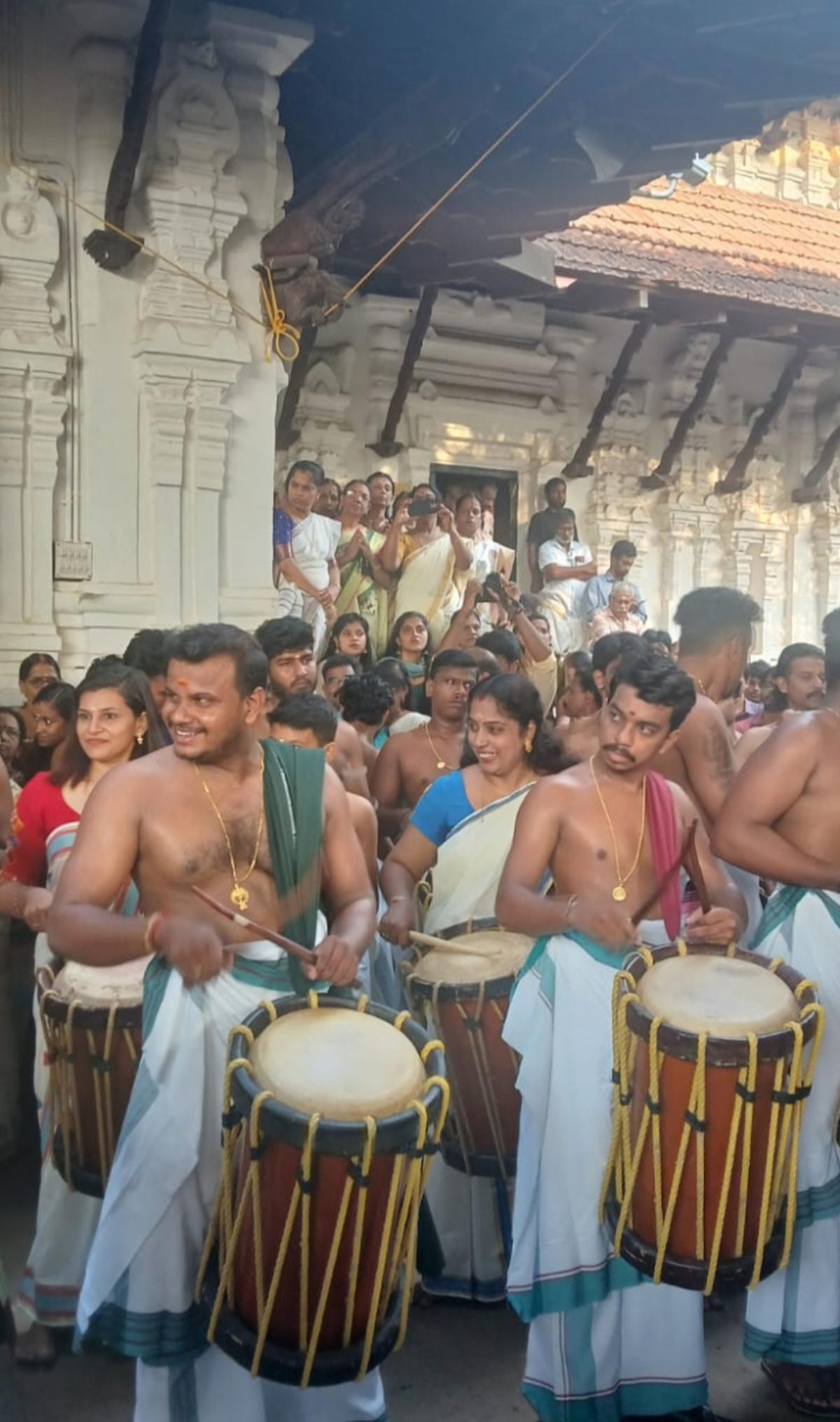Aswathy Jithin and Archana Anoop break the glass ceiling at Thrissur Pooram
| Photo Credit: Special Arrangement
Thunderous fireworks, parading elephants, kudamattom (display of colourful parasols), and more. The Thrissur Pooram that dates back to 1796 draws thousands of visitors every year at the famed Vadakkumnathan temple. In the popular number ‘Kaanta’ by the band Masala Coffee, a woman asks her beloved if she can accompany him to the Pooram. The song goes on to describe what she would witness and do at the festival. One of the lines goes: ‘Thimila anikonne kaananam kaanthaa… Thimilayil athilonne kottanam kaanthaa’, loosely translated to, “I want to see the hour-glass shaped drum, I want to play the hour-glass shaped drum’.
Now, two women — Aswathy Jithin, 35, and Archana Anoop, 42, from Poomkunnam — not only played the thimila, but also were a part of pandi melam, one of the main percussion sets, becoming the first women to be part of the chenda melam at the Pooram.
Aswathy, a native of Thrissur, grew up watching the Pooram. Marriage to Jithin Kallat, one of the main percussionists at the event, piqued her interest in the chenda. Her 13-year-old son Adithya learnt the chenda, and when he was about to have his debut performance in 2018, Aswathy was inspired to start learning. After learning for a year, she made her debut in 2019.
Archana’s story is similar. Three months into her son Udhav learning the chenda, she started training under Jithin, and made her debut in 2023, on Deepavali.
Says Aswathy: “My husband Jithin has been playing at the Pooram for 10 years now. This year, Archana chechi (elder sister) and I approached him and professed our wish to take part in it too. He agreed. The Devaswom Board did too. And thus, we got to be a part of valamthala or the right hand side of the percussion, in one of the back rows. The duo was part of the pandi melam, which is part of the procession to bring in shasthavu or Ayyapan’s idol via the southern gate, and ending at the western gopuram.
This isn’t the first time women have been a part of the Pooram — in 2024, Hridya, a native of Thanikkudam, and Sreepriya, a native of Mulankunnathukavu, played the kuramkuzhal or wooden wind instrument similar to the flute.
“Our families have been very supportive,” says Archana, adding “My mother has been receiving congratulatory calls.”

Aswathy and Archana Anoop performing at Thrissur Pooram
| Photo Credit:
Special Arrangement
The duo has till now been a part of at least 10 chenda melams, including those at Shankarakulangara Bhagavathy temple and Kanimangala Shastha temple. Aswathy says she has always felt a close association with the Pooram as her father, C. Nandakumar was a member of the Thrissur Pooram Ekopana Samithi, the group that ensures the pooram functions smoothly. “We have always gone for poorams — not just the one at Thrissur — as a family and returned home in the wee hours of the morning,” she says. Like Aswathy, Archana too says she never had such aspirations as a child, but was musically inclined. Incidentally, both Archana and Aswathy were part of the marching bands at their respective schools in Palakkad and Thrissur. “I suppose, we both were destined to be involved in music in some way,” Archana says. Both women now have set their sights on learning sopana sangeetham (sacred ritualistic songs, usually sung at a temple’s nada or doorway).
The chendas are heavy, weighing about 13-14 kg. “It is a bit difficult to become one with the chenda when you start out; you tend to suffer from shoulder pain and body ache, but you get used to it. And while performing you usually get immersed in it, which makes you forget about the pain,” she says.
The day before their performance, the women didn’t think much of it. “But on the morning of the Pooram, it dawned on me that it is the first time two women will play the chenda at Thrissur Pooram, an event Malayalees across the globe watch. But, once we started the melam, all the nervousness melted away,” Aswathy says. “All the other artistes were very supportive as we joined the row of percussionists. We hope to be a part of Poorams at other temples too,” adds Archana.
Published – May 07, 2025 07:41 pm IST